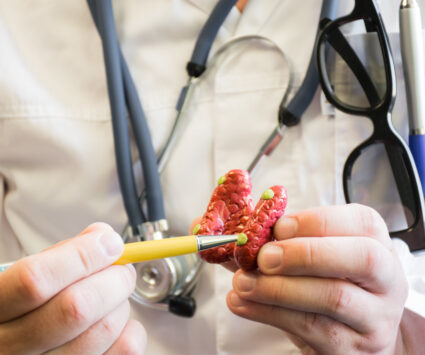Pathology is a vast field with many branches. Anatomic pathology involves the study of how diseases affect body organ structure. Anyone undergoing a biopsy has their specimen examined by an anatomic pathologist.
What Is Anatomic Pathology?
When blood or urine samples are provided for diagnostic purposes, laboratory scientists usually conduct the analysis. When tissue samples— such as those from a biopsy or surgical resection — require evaluation, that is the job of the anatomic pathologist. Histopathology, the foundation of anatomic pathology, involves this form of examination. Specimens are rendered into slides, placed under a microscope and used for the purpose of histologic diagnosis. When it comes to cancer, this is the best method for detecting the presence of it. Pathologists may use special staining techniques in their work or conduct antibody tests to identify various tissue components.
The anatomic pathologist will determine the type of disease present, as well as the extent of the disease. For instance, tissue removed under biopsy is cut into thin sections, placed onto slides and stained with dyes. The pathologist then proceeds with the evaluation.
After completing the evaluation, the pathologist issues a pathology report about the diagnosis. This report contains the gross description which is the size, shape and appearance of the specimen under the naked eye. It also includes the microscopic description —how the sample appears under the microscope in relation to normal cells. The diagnosis includes:
- Type of tumor
- Grade (How fast it is likely to grow)
- Size (Measured in centimeters)
- Margins (Whether there are cancer cells at the edge of the removed mass)
How Is Anatomic Pathology Different From Other Types of Pathology?
Most people diagnosed with cancer likely have more experience with clinical pathology which involves blood tests, glucose testing, throat cultures and the like. The subspecialties of clinical pathology include immunology, hematology and chemistry.
Conversely, anatomic pathology consists of various specialties and subspecialties including:
- Cytopathology: Small amounts of tissue retrieved from fine needle aspiration or surface scraping is examined in this field of anatomic pathology. Obtaining this tissue is minimally invasive. So, the procedure is usually done in a doctor’s office rather than a hospital. Cells are examined to ascertain whether malignancy is present.
- Decedent pathology: In these cases, the patient has already died. It is the work of the anatomic pathologist to identify the diseases the person had, their extent and the cause of death. It is also known as an autopsy or forensic pathology.
- Neuropathology: This field studies diseases of the nervous system. This includes the brain, spinal cord and the body’s nerve system network.
- Ophthalmic pathology: This subspecialty focuses on the eyes, as well as nearby tissues.
- Surgical pathology: This involves an examination of tissue removed after a biopsy or surgery. Surgical pathology is associated with a broad range of surgical specialties including medical oncology, gastroenterology, urology, dermatology and more. The surgical pathologist works with and advises clinicians regarding diagnosis, prognosis and therapies for the particular type of disease.
Advantages of Anatomic Pathology Practices
Anatomic pathology benefits extend far beyond the correct diagnosis of a disease or condition, although this work alone is vital. It also includes:
- Disease progression monitoring
- Treatment effects monitoring
- Identifying potential to develop disease
Anatomic Pathology Services
When it comes to anatomic pathology, Yosemite Pathology and Precision Pathology has led the way in the Western United States since its founding in 1948. It was a woman, Dr. Jeanne Miller, a University of California San Francisco trained pathologist, who started the company more than 70 years ago. Since then, we have been committed to providing superior and comprehensive diagnostics in anatomic pathology. Our broad range of specialties in the field of cancer treatment offered by our dedicated pathologists includes those of the breast, skin, thyroid, gastrointestinal system and more.
For more information about our services, contact us today.
Jane Meggitt’s work has appeared in dozens of publications including USA Today, Zack’s, Financial Advisor, nj.com, The Houston Chronicle and The Nest. She is a graduate of New York University.
Sources
Yale Medicine – Anatomic Pathology
UCLA Health – Anatomic Pathology
University of Pittsburgh – Neuropathology
Duke University School of Medicine – Ophthalmic Pathology

